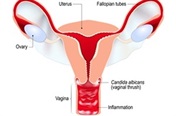
Summary
- Vaginal candidiasis, also known as "candida infection" or "yeast infection", is a common infection caused by strains of candida fungi, or yeast, especially Candida albicans.
- Candida fungi can occur harmlessly in the body, often in the intestine, but under certain conditions (such as a compromised immune system), they can proliferate and cause infection.
- Candida infection may be present in different parts of the body such as the mouth, vagina and skin.
- Candida overgrowth has a number of causes, including antibiotics, a compromised immune system, hormonal imbalance, stress and inadequate diet.
- In otherwise healthy individuals, candida infections can usually be eliminated with a short course of antifungal medication.
Alternative names
Vaginal yeast infection; Vaginal candida
What is vaginal candidiasis?
Candida normally lives harmlessly in the body, but under certain conditions it may multiply out of control. Candida can affect different parts of the body, causing either localised infections or overwhelming illness, depending on the individual's general state of health.
Yeast infection of the vaginal area is common. If the infection is also present at the vulva (the area around the entrance to the vagina), the condition is known as vulvovaginal candidiasis. The infection commonly occurs as a result of self-contamination with yeast organisms from the rectal passage.
Sexual transmission is possible but unusual. Vaginal candida infections are not usually transmitted sexually. They are often listed among sexually transmitted infections only because they may occur with other types of reproductive system infections.
What causes vaginal candidiasis?
Candidiasis, also known as "Candida" or "yeast", is an infection caused by strains of Candida fungi, especially Candida albicans. Candida fungi usually live harmlessly along with the "friendly" species of bacteria that normally colonise the mouth and gastrointestinal and urogenital tracts.
In a healthy person, the growth of candida is kept in check by a properly functioning immune system and the presence of friendly bacteria.
However, certain internal and external factors can change the normal environment and trigger an overgrowth of the yeast. Candida fungi can multiply out of control if the numbers of friendly bacteria are reduced, the immune system is weakened, or other conditions for yeast proliferation occur.
When fungal growth at a certain body site exceeds the body's ability to control it, yeast infection develops.
What are the risk factors for candidiasis?
The following are factors that can predispose one to candida overgrowth:
- Antibiotics can reduce the number of friendly intestinal bacteria which normally help to keep candida under control.
- Medications such as steroid hormones, immunosuppressant and anti-inflammatory drugs, chemotherapy drugs and ulcer medications or acid blockers used for prolonged periods.
- Immune deficiency. Diseases such as Aids and cancer can weaken the immune system. The immune system can also become weaker in the elderly.
- Diabetics are prone to yeast infections, especially when their blood sugar levels are not well controlled. High levels of sugar in the blood and urine, and a low resistance to infection are conditions that encourage yeast growth.
- Certain genetic disorders, such as coeliac disease (which involves intestinal malabsorption) or haemochromatosis (in which iron accumulates in body tissue).
- Hormonal imbalance, as a result of menstruation, pregnancy, diabetes or birth control pills (usually in the first three months of taking them) or thyroid disease.
- Women tend to be more susceptible to vaginal yeast infections if they are under stress, have an inadequate diet, lack sleep or are ill. Although it is not classified as a sexually transmitted infection, yeast infections are common among younger women (ages 20 to 40), especially after becoming sexually active. During their lifetimes, about 75 percent of all women are likely to have at least one vaginal candida infection before they reach menopause, and up to 45 percent will have two or more.
- When the balance between commensal (friendly) and pathogenic (disease-causing) bacteria in the normal intestinal flora is disturbed, for example due to excessive alcohol consumption and certain chemicals.
- A moist, warm environment. Yeast infections often develop where a moist, warm environment encourages fungal growth. Prime areas include the webs of fingers and toes, nails, genitals and folds of skin. This is particularly the case in diabetics.
- Tight clothing, especially underwear, that promotes moisture build-up.
- Being obese (more than 20 percent overweight).
- People whose work requires that they spend long periods of time with their hands in water, or who wear rubber gloves, are predisposed to cutaneous candidiasis.
- In rare cases, the candida fungus may invade the body at certain sites: intravenous (IV) tube, urinary catheter, tracheostomy, ventilation tubing or surgical wounds. If the infection spreads through the bloodstream to the kidneys, lungs, brain or other organs, it can cause serious systemic complications. These develop only in people who are seriously ill or who have other health problems that weaken the immune system.
Other things to bear in mind
- If a woman has a vaginal yeast infection when she gives birth, the baby may get yeast (thrush) in its throat or digestive tract.
- Thrush is a common minor infection in babies and young children.
What are the symptoms and signs of vaginal candidiasis?
Vaginal yeast infections may cause the following symptoms:
- Vaginal itching and/or soreness.
- A thick, white discharge which may resemble cottage cheese and smell like baking bread.
- Burning discomfort around the vaginal opening, especially when urinating.
- Pain or discomfort during sexual intercourse.
- Redness and swelling of the vulva.
- Some women infected with Candida have no symptoms.
How is a diagnosis made?
The doctor will take a detailed medical history and will also ask about recent use of medications that could suppress the immune system.
Vaginal yeast infection can often be diagnosed by a simple physical examination and viewing a scraping sample through a microscope at the doctor's office. However, if the diagnosis is in question, the doctor may send a sample of vaginal discharge to the laboratory for testing.
If the doctor suspects an underlying medical condition that increases the risk for candidiasis — such as diabetes, cancer or HIV infection — blood tests or other types of diagnostic procedures may be necessary.
How is it treated?
After having made the diagnosis, the doctor will prescribe the necessary medication. Treatment of candidiasis aims to curb the growth of the organism that causes the infection. It depends on the severity of the infection and whether it is a first-time or recurrent infection. Antifungal drugs resolve most cases of common yeast infection.
Vaginal yeast infections can be treated with topical antifungal medications administered directly into the vagina as creams, ointments or suppositories. These medications include nystatin and so-called imidazole derivatives (clotrimazole, econazole, fenticonazole, ketoconazole, tioconazole, terconazole and miconazole.) Patients with recurrent infections are often treated with systemic antifungals. While taking antifungal medications:
- Complete the full treatment even if you start feeling better.
- Continue the course of treatment if you are menstruating.
- Do not douche.
- Avoid sexual intercourse when there is active infection.
- To ease discomfort, try applying a cold compress, such as a wash cloth, to the labial area several times a day. Ask your doctor or pharmacist to recommend an anti-itch medication.
- After urinating, wipe gently to avoid irritation.
- It may take a week or more for inflammation and burning to subside even though the infection has been properly treated.
In most otherwise-healthy individuals with superficial candidiasis, the infection can be treated without leaving permanent damage. It is unlikely to return as long as the person remains healthy and well-nourished.
However, in people with weakened immune systems, candida infections can be difficult to treat and may recur. In these cases, candidiasis can sometimes be life-threatening if it passes into the blood and spreads to vital organs like the lungs, kidney, heart and brain, where it can be fatal.
People with severely compromised immune systems can die from a form of blood poisoning known as candida septicaemia. Cases of systemic candidiasis that are diagnosed quickly and treated effectively have the best prognosis, especially if the infection can be stopped before it spreads to major organs.
Home treatment
There have been several home remedies described, such as applying plain yoghurt to the vulva or directly into the vagina, or drinking unsweetened cranberry juice to curb candida overgrowth. Some women may find these helpful in relieving part of the discomfort associated with candidiasis. However, the disadvantage as with any self medication is that the diagnosis is not made by a medical professional.
A woman suffering from an itchy discharge may have a candida vulvovaginitis and an STI simultaneously and, by delaying a proper examination with the correct diagnosis and necessary treatment, the condition may become worse. Therefore, it is best to consult a doctor.
When to call your doctor
A woman should be attended by a doctor if she experiences symptoms of a candida infection and:
- this is the first time that she has such symptoms;
- the infection does not respond to the prescribed treatment or recurs within a two-month period;
- she suffers from a chronic illness or weakened immune system, or is taking medication to suppress the immune system;
- she is pregnant.
How can it be prevented?
You can help to prevent candida infections by:
- Avoiding frequent or prolonged use of oral antibiotics if possible.
- Losing weight if obese.
- Keeping blood sugar levels as normal as possible if suffering from diabetes.
- The skin of the vulva and anus should be washed regularly and kept dry after bathing. Other people's towels or washcloths should not be used.
- The use of chemical products such as bubble bath, hygiene spray, irritating soaps, perfumes or talcum powder should be avoided or kept to a minimum.
- Dry cotton or silk underclothes allow better airing and evaporation of excess moisture. Any tight-fitting garments should be avoided, particularly when exercising.
- Vaginal douching should be avoided. The vagina does not require cleansing other than normal bathing. Repetitive douching disrupts the balance of normal organisms that live in the vagina and can actually increase the risk of vaginal infection.
- If a genital candida infection is present, a condom should be used during sexual intercourse. Although uncommon, candida organisms can also be transmitted through kissing and orogenital contact.
- For people with HIV who are at risk of recurrent episodes of thrush, doctors sometimes prescribe antifungal drugs as a preventative measure.
(Ilse Pauw, Health24, January 2008)
Reviewed by Prof B. Schaetzing MD, FCOG(SA), FRCOG, PhD. Part-time Consultant, Dept of Obstetrics & Gynaecology, Faculty of Health Sciences, University of Stellenbosch.




 Publications
Publications
 Partners
Partners











